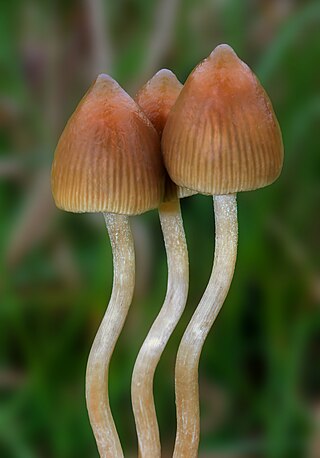
Psilocybe semilanceata, commonly known as the liberty cap, is a species of fungus which produces the psychoactive compounds psilocybin, psilocin and baeocystin. It is both one of the most widely distributed psilocybin mushrooms in nature, and one of the most potent. The mushrooms have a distinctive conical to bell-shaped cap, up to 2.5 cm (1 in) in diameter, with a small nipple-like protrusion on the top. They are yellow to brown, covered with radial grooves when moist, and fade to a lighter color as they mature. Their stipes tend to be slender and long, and the same color or slightly lighter than the cap. The gill attachment to the stipe is adnexed, and they are initially cream-colored before tinting purple to black as the spores mature. The spores are dark purplish-brown in mass, ellipsoid in shape, and measure 10.5–15 by 6.5–8.5 micrometres.

Psilocybe cyanescens, commonly known as the wavy cap or potent psilocybe, is a species of potent psychedelic mushroom. The main compounds responsible for its psychedelic effects are psilocybin and psilocin. It belongs to the family Hymenogastraceae. A formal description of the species was published by Elsie Wakefield in 1946 in the Transactions of the British Mycological Society, based on a specimen she had recently collected at Kew Gardens. She had begun collecting the species as early as 1910. The mushroom is not generally regarded as being physically dangerous to adults. Since all the psychoactive compounds in P. cyanescens are water-soluble, the fruiting bodies can be rendered non-psychoactive through parboiling, allowing their culinary use. However, since most people find them overly bitter and they are too small to have great nutritive value, this is not frequently done.

Hydnum repandum, commonly known as the sweet tooth, pig's trotter, wood hedgehog or hedgehog mushroom, is a basidiomycete fungus of the family Hydnaceae. First described by Carl Linnaeus in 1753, it is the type species of the genus Hydnum. The fungus produces fruit bodies (mushrooms) that are characterized by their spore-bearing structures—in the form of spines rather than gills—which hang down from the underside of the cap. The cap is dry, colored yellow to light orange to brown, and often develops an irregular shape, especially when it has grown closely crowded with adjacent fruit bodies. The mushroom tissue is white with a pleasant odor and a spicy or bitter taste. All parts of the mushroom stain orange with age or when bruised.
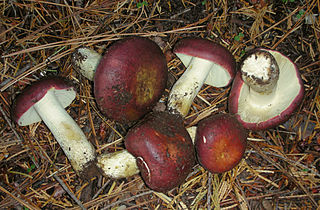
Russula xerampelina, also commonly known as the shrimp russula, crab brittlegill, or shrimp mushroom, is a basidiomycete mushroom of the brittlegill genus Russula. Two subspecies are recognised. The fruiting bodies appear in coniferous woodlands in autumn in northern Europe and North America. Their caps are coloured various shades of wine-red, purple to green. Mild tasting and edible, it is one of the most highly regarded brittlegills for the table. It is also notable for smelling of shellfish or crab when fresh.

Sarcodon imbricatus, commonly known as the shingled hedgehog or scaly hedgehog, is a species of tooth fungus in the order Thelephorales. The mushroom is edible. Many sources report it has a bitter taste, but others have found it delicious and suspect that the bitter specimens may be similar related species. The mushroom has a large, brownish cap with large brown scales and may reach 30 cm (12 in) in diameter. On the underside it sports greyish, brittle teeth instead of gills, and has white flesh. Its spore print is brown. It is associated with spruce (Picea), appearing in autumn. It ranges throughout North America and Europe, although collections from the British Isles are now assigned to the similar species Sarcodon squamosus.

Lactarius vietus is a species of fungus in the family Russulaceae, first described by Elias Magnus Fries. It produces moderately sized and brittle mushrooms, which grow on the forest floor or on rotting wood. The flattened-convex cap can vary in shape, sometimes forming the shape of a wide funnel. It is typically grey, but the colour varies. The species has crowded, light-coloured gills, which produce white milk. The spore print is typically whitish, but also varies considerably. The mushrooms typically have a strong, acrid taste and have been described as inedible, but other authors have described them as consumable after boiling. L. vietus feeds by forming an ectomycorrhizal relationship with surrounding trees, and it favours birch. It grows in autumn months and is fairly common in Europe, North America and eastern Asia.

Russula fragilis, commonly known as the fragile russula, or fragile brittlegill, is a species of mushroom of the genus Russula, whose members are commonly known as brittlegills. It is a small, fragile, long stemmed, and variably coloured brittlegill, found in mixed forests, and woods in Europe, Asia, and North America.

Aureoboletus mirabilis, commonly known as the admirable bolete, the bragger's bolete, and the velvet top, is an edible species of fungus in the Boletaceae mushroom family. The fruit body has several characteristics with which it may be identified: a dark reddish-brown cap; yellow to greenish-yellow pores on the undersurface of the cap; and a reddish-brown stem with long narrow reticulations. Aureoboletus mirabilis is found in coniferous forests along the Pacific Coast of North America, and in Asia. Unusual for boletes, A. mirabilis sometimes appears to fruit on the wood or woody debris of Hemlock, suggesting a saprobic lifestyle. Despite occasional appearances to the contrary, Aureoboletus mirabilis is mycorrhizal, and forms close mutualistic associations with hemlock roots.
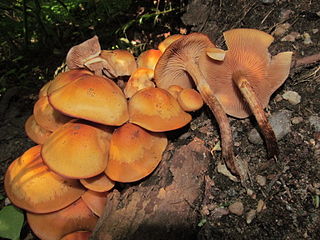
Armillaria nabsnona is a species of fungus in the family Physalacriaceae. The species is found in the west coast of North America, Hawaii, and Japan, where it grows on decaying hardwoods, particularly species of alder. Its fruit bodies have convex to flattened orange-brown caps up to 7 cm in diameter, brown stipes, and whitish to pinkish-tan gills.

Amanita aestivalis, commonly known as the white American star-footed amanita, is a species of fungus in the mushroom family Amanitaceae. The cap of the white fruit body is 5 to 8.5 centimetres in diameter. It sits atop a stem that is 8.5 to 16 cm long. The entire fruit body will slowly stain a reddish-brown color in response to bruising. A. aestivalis may be a synonym for A. brunnescens, and may be confused with several other white-bodied amanitas. The fungus is distributed in eastern North America.

Psilocybe aztecorum is a species of psilocybin mushroom in the family Hymenogastraceae. Known from Arizona, Colorado, central Mexico, India and Costa Rica, the fungus grows on decomposing woody debris and is found in mountainous areas at elevations of 2,000 to 4,000 m, typically in meadows or open, grassy conifer forests. The mushrooms have convex to bell-shaped caps 1.5–2 cm (0.6–0.8 in) in diameter, atop slender cylindrical stems that are up to 7.5 cm (3.0 in) long. The color of the caps changes with variations in hydration, ranging from dark chestnut brown to straw yellow or whitish when dry. The base of the stem is densely covered with conspicuous white rhizomorphs, a characteristic uncommon amongst Psilocybe species.

Pulveroboletus bembae is a species of fungus in the family Boletaceae that was first described in 2009. It is known only from the rainforest of northern Gabon, a region known for its high level of species diversity. Like all boletes, P. bembae has fleshy fruit bodies that form spores in tubes perpendicular to the ground on the underside of the cap. These yellowish tubes form a surface of pores, each about 1–2 mm in diameter. The brownish caps may reach up to 3.5 cm (1.4 in) wide, and rest atop pale brown stems up to 5.5 cm (2.2 in) long. The stems have a woolly, whitish yellow ring of tissue that is short-lived, and may be absent in older specimens. The spores of P. bembae are spindle- or fuse-shaped, and have rough surfaces—a detail observable when viewed with scanning electron microscopy. The fungus grows in a mycorrhizal relationship with Gilbertiodendron dewevrei, the dominant tree species of the Guineo-Congolian rainforest. Other similar Pulveroboletus species in the area include P. annulus and P. croceus, which may be differentiated from P. bembae by a combination of macro- and microscopic characteristics.

Amanita exitialis, also known as the Guangzhou destroying angel, is a mushroom of the large genus Amanita. It is distributed in eastern Asia, and probably also in India where it has been misidentified as A. verna. Deadly poisonous, it is a member of section Phalloideae and related to the death cap A. phalloides. The fruit bodies (mushrooms) are white, small to medium-sized with caps up to 7 cm (2.8 in) in diameter, a somewhat friable ring and a firm volva. Unlike most agaric mushrooms which typically have four-spored basidia, the basidia of A. exitialis are almost entirely two-spored. Eight people were fatally poisoned in China after consuming the mushroom in 2000, and another 20 have been fatally poisoned since that incident. Molecular analysis shows that the species has a close phylogenetic relationship with three other toxic white Amanitas: A. subjunquillea var. alba, A. virosa and A. bisporigera.
Strobilomyces foveatus is a little-known species of fungus in the family Boletaceae. It was first reported by mycologist E.J.H. Corner in 1972, from specimens he collected in Malaysia in 1959, and has since been found in Australia. Fruit bodies are characterized by the small dark brown to black conical scales covering the cap, and the net-like pattern of ridges on the upper stem. The roughly spherical spores measure about eight micrometres, and are densely covered with slender conical spines. The edibility of this species is unknown.

Amanita australis is a species of fungus in the family Amanitaceae. It produces small- to medium-sized fruit bodies, with brown caps up to 9 centimetres in diameter covered with pyramidal warts. The gills on the underside of the cap are white, closely crowded together, and free from attachment to the stem. The stem, up to 9 cm long, has a ring and a bulbous base. The mushroom may be confused with another endemic New Zealand species, A. nothofagi, but can be distinguished by differences in microscopic characteristics.

Amanita nothofagi is a species of fungus in the family Amanitaceae. Endemic to New Zealand, the species was first described by mycologist Greta Stevenson in 1962. The fruit bodies have dark brown caps that are up to 13 cm (5.1 in) in diameter and covered with patches of soft greyish-brown scales or warts. The gills underneath the cap are crowded together, free from attachment to the stem, and white, becoming tinged with yellow in age. The stem of the mushroom is 4–14 cm (1.6–5.5 in) long by 0.5–2.5 cm (0.2–1.0 in) thick, and has a ring. The spore print is white, and individual spores are spherical to ellipsoid, measuring 7.5–9 by 7.5–9 micrometres. The mushroom may be confused with another New Zealand species, A. australis, but can be distinguished by certain characteristics. Amanita nothofagi is a mycorrhizal species, and grows in association with native New Zealand trees such as Southern Beech.
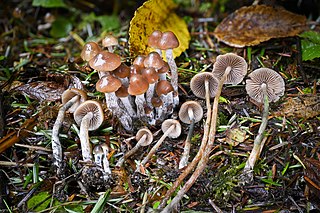
Psilocybe pelliculosa is a species of fungus in the family Hymenogastraceae. The fruit bodies, or mushrooms, have a conical brownish cap up to 2 cm in diameter atop a slender stem up to 8 cm long. It has a white partial veil that does not leave a ring on the stem. American mycologist Alexander H. Smith first described the species in 1937 as a member of the genus known today as Psathyrella; it was transferred to Psilocybe by Rolf Singer in 1958.

Infundibulicybe geotropa, also known as the trooping funnel or monk's head, is a funnel-shaped toadstool widely found in Europe and in North America. A large sturdy cream- or buff-coloured funnel-shaped mushroom, it grows in mixed woodlands, often in troops or fairy rings, one of which is over half a mile wide. Although edible, it could be confused with some poisonous species of similar colouration and size.
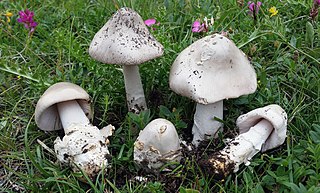
Amanita nivalis, the snow ringless amanita or mountain grisette, is a species of basidomycote fungus in the genus Amanita.

Lepiota castaneidisca is a species of agaric fungus in the family Agaricaceae. Formally described in 1912, it was for a long time considered the same species as the similar Lepiota cristata until molecular analysis reported in 2001 demonstrated that it was genetically distinct. It is most common in coastal and northern California, and has also been recorded in Mexico. A saprobic species, it is usually found under redwood and Monterey cypress. Its fruit bodies (mushrooms) have white caps with an orange-red to orange-brown center that measure up to 3.2 cm (1.3 in) wide. The cream-colored to light pink stems are up to 6.5 cm (2.6 in) long by 0.2–0.6 cm (0.1–0.2 in) thick, and have a ring. L. castaneidisca can be distinguished from other similar Lepiota species by differences in habitat, macroscopic, or microscopic characteristics.


















